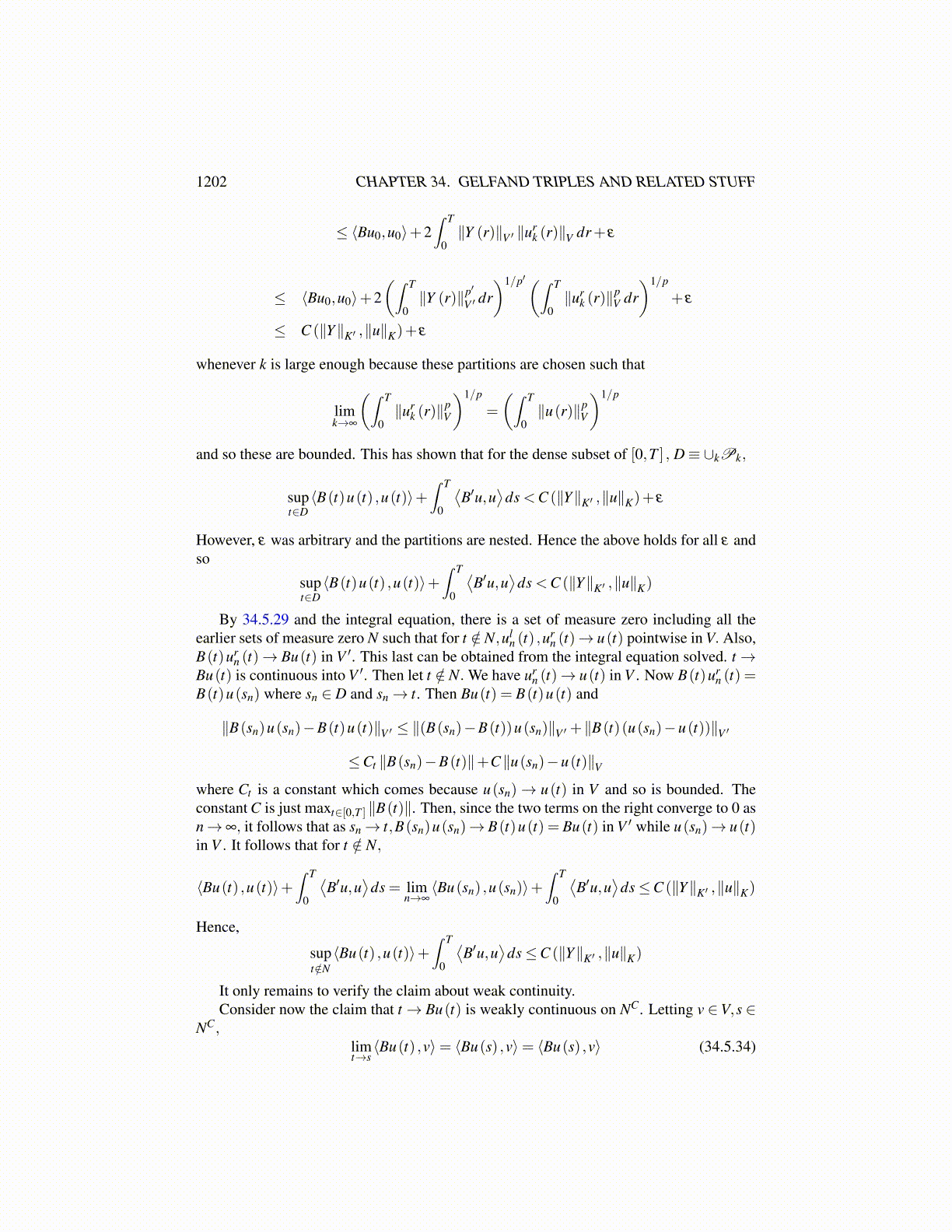
1202 CHAPTER 34. GELFAND TRIPLES AND RELATED STUFF
≤ ⟨Bu0,u0⟩+2∫ T
0∥Y (r)∥V ′ ∥u
rk (r)∥V dr+ ε
≤ ⟨Bu0,u0⟩+2(∫ T
0∥Y (r)∥p′
V ′ dr)1/p′(∫ T
0∥ur
k (r)∥pV dr
)1/p
+ ε
≤ C (∥Y∥K′ ,∥u∥K)+ ε
whenever k is large enough because these partitions are chosen such that
limk→∞
(∫ T
0∥ur
k (r)∥pV
)1/p
=
(∫ T
0∥u(r)∥p
V
)1/p
and so these are bounded. This has shown that for the dense subset of [0,T ] , D≡ ∪kPk,
supt∈D⟨B(t)u(t) ,u(t)⟩+
∫ T
0
⟨B′u,u
⟩ds <C (∥Y∥K′ ,∥u∥K)+ ε
However, ε was arbitrary and the partitions are nested. Hence the above holds for all ε andso
supt∈D⟨B(t)u(t) ,u(t)⟩+
∫ T
0
⟨B′u,u
⟩ds <C (∥Y∥K′ ,∥u∥K)
By 34.5.29 and the integral equation, there is a set of measure zero including all theearlier sets of measure zero N such that for t /∈ N,ul
n (t) ,urn (t)→ u(t) pointwise in V. Also,
B(t)urn (t)→ Bu(t) in V ′. This last can be obtained from the integral equation solved. t→
Bu(t) is continuous into V ′. Then let t /∈ N. We have urn (t)→ u(t) in V . Now B(t)ur
n (t) =B(t)u(sn) where sn ∈ D and sn→ t. Then Bu(t) = B(t)u(t) and
∥B(sn)u(sn)−B(t)u(t)∥V ′ ≤ ∥(B(sn)−B(t))u(sn)∥V ′ +∥B(t)(u(sn)−u(t))∥V ′
≤Ct ∥B(sn)−B(t)∥+C∥u(sn)−u(t)∥Vwhere Ct is a constant which comes because u(sn)→ u(t) in V and so is bounded. Theconstant C is just maxt∈[0,T ] ∥B(t)∥. Then, since the two terms on the right converge to 0 asn→∞, it follows that as sn→ t,B(sn)u(sn)→ B(t)u(t) = Bu(t) in V ′ while u(sn)→ u(t)in V . It follows that for t /∈ N,
⟨Bu(t) ,u(t)⟩+∫ T
0
⟨B′u,u
⟩ds = lim
n→∞⟨Bu(sn) ,u(sn)⟩+
∫ T
0
⟨B′u,u
⟩ds≤C (∥Y∥K′ ,∥u∥K)
Hence,
supt /∈N⟨Bu(t) ,u(t)⟩+
∫ T
0
⟨B′u,u
⟩ds≤C (∥Y∥K′ ,∥u∥K)
It only remains to verify the claim about weak continuity.Consider now the claim that t→ Bu(t) is weakly continuous on NC. Letting v ∈V,s ∈
NC,limt→s⟨Bu(t) ,v⟩= ⟨Bu(s) ,v⟩= ⟨Bu(s) ,v⟩ (34.5.34)